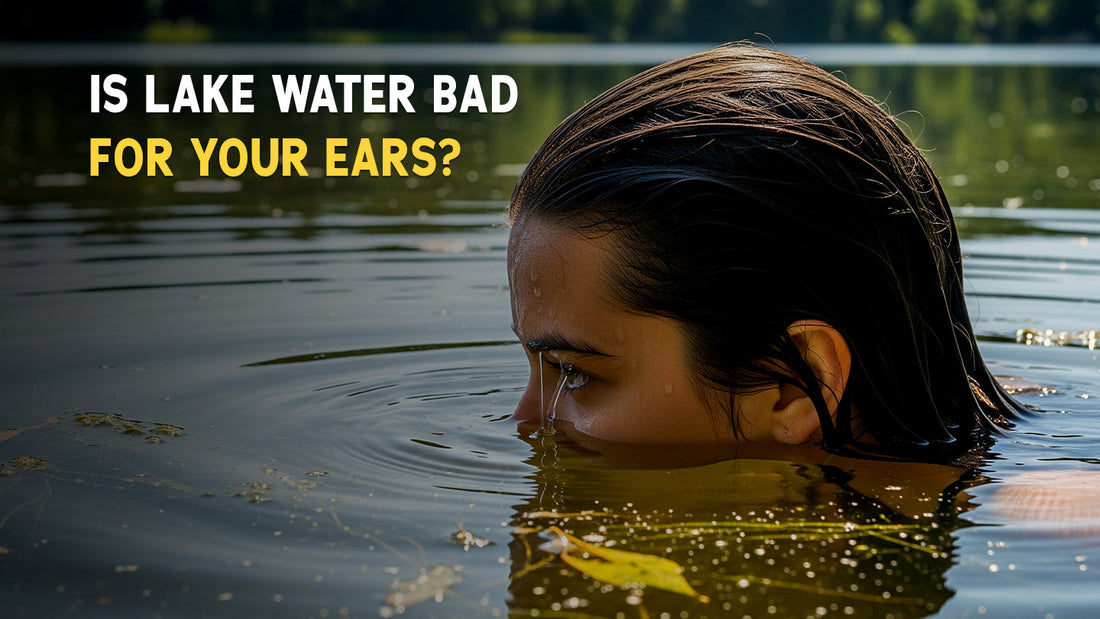
Is Lake Water Bad for Your Ears?
Share
Freshwater lakes and rivers invite families to cool off during long summer days, yet many swimmers leave the shoreline asking, Is lake water safe for ears?
The short answer: not always. Warm, still water can let microbes thrive inside the narrow ear canal, turning a fun weekend into a painful infection.
Recent medical research shows that people who swim in untreated lakes every week are far more likely to develop outer‑ear infections than those who stay on dry land.
This article explains why that happens, what symptoms to watch for, and how to protect yourself with practical steps.
TL;DR — Key Points at a Glance
-
Freshwater carries a higher outer‑ear infection risk than treated pools, because warm, still water lets bacteria, especially Pseudomonas aeruginosa, thrive quickly
-
Children, frequent lake swimmers, and people with skin conditions are most vulnerable; habits such as cotton‑swab use or wearing tight earbuds further raise the odds of infection
-
Early signs include itching, pain when the earlobe is pulled, fullness, or clear fluid. Recognizing these clues and starting care early prevents severe cases
-
Serious complications are rare but possible if symptoms are ignored; infections can become chronic or spread to bone, sometimes requiring hospital treatment
-
Prevention relies on three steps: drain and dry ears after every swim, create a mineral‑oil barrier with Ear Pro before and after water exposure, and choose clean, flowing swimming spots
Understanding the Ear Canal
Your ear canal is a narrow, self‑cleaning passage that relies on wax to stay balanced.
Anatomy of the Outer Ear
The outer ear canal is a thin, slightly curved tube lined with delicate skin and a light coating of protective wax.
This wax keeps the canal balanced and repels moisture. If lake water sits inside the canal, it raises humidity, strips away wax, and softens the skin, perfect conditions for germs to multiply.
Definition of Otitis Externa (Swimmer’s Ear)
Otitis externa, often called swimmer’s ear, is an infection of the outer ear canal.
The first signs are itchiness or a dull ache that worsens when you tug the earlobe. Left untreated, the canal can swell shut, causing hearing loss, pus drainage, and severe pain.
How Fresh Water Promotes Infection
Lake water disrupts that balance, inviting microbes to settle and multiply.
Warm, Trapped Water and Bacterial Growth
Unlike chlorinated pools, lakes rarely have chemicals that curb microbial growth. Warm temperatures and natural debris encourage colonies of bacteria in lake water to flourish.
Studies have measured a sharp increase in infections when swimmers spend five or more days in a single season submerging their heads under lake water.
Key Micro‑Organisms Linked to Ear Infections
One pathogen stands out: Pseudomonas aeruginosa. It quickly colonizes moist surfaces and penetrates broken skin.
In clinical testing, more than eight out of ten infected ears carried this bacterium, and every sampled lake contained it.
While Pseudomonas is seldom dangerous for healthy skin, it thrives once moisture softens the canal lining.
Why Do Ears Itch After Lake Swimming?
When wax dilutes, skin absorbs water, swells, and pulls tight against nerve endings.
Early itchiness signals irritation well before severe ear infections from swimming develop, making it a warning swimmers should never ignore.
Groups at Higher Risk
Children, frequent swimmers, and people with skin conditions face the highest odds.
Children, Frequent Swimmers, and Individuals with Skin Conditions
Children aged seven to fourteen top the infection charts because they spend longer in the water.
Adults with eczema or psoriasis face similar risks, and athletes who train in open water multiple times a week show the highest incidence. For them, ear safety in natural water requires extra vigilance.
Behaviors That Increase Risk (Cotton Swabs, Earbuds)
Rough towel drying, cotton swabs, and tight earbuds can scratch canal skin and remove wax. Any tiny cut lets bacteria invade.
Habitual swab users recorded double the risk of swimmer’s ear in lakes compared with those who let their ears drain naturally.
Can Prior Ear Problems Raise Future Infection Risk?
Yes. A history of outer‑ear infections leaves small scarred areas that trap moisture faster.
People with past ear disease experience new episodes sooner and more frequently than first‑time sufferers.
Early Symptoms to Watch For
A mild itch or tugging pain often signals the first stage of infection.
The Ear‑Lobe Pull Test
Gently pull the earlobe. Sharp pain suggests early infection. Swimmers who catch this stage and begin care usually avoid antibiotics and recover quickly.
Common Signs: Drainage, Itching, Fullness
Clear fluid or pus that leaks onto your pillow, constant scratching, or a feeling that the ear is “blocked” often appear within 24 hours of exposure.
Recognizing these clues helps you take proper precautions before complications set in.
When Should You Consult a Clinician?
Seek medical help if pain disturbs sleep, swelling shuts the canal, or fever appears. Timely drops clear most cases inside a week.
Possible Complications
Unchecked infection can spread deeper and turn a simple irritation into chronic trouble.
Progression from Acute to Chronic Infection
Ignoring symptoms can let swelling linger for months, creating chronic otitis externa. Scar tissue narrows the canal, trapping new moisture and restarting the cycle.
Less Common but Serious Outcomes
In rare cases, infection spreads to adjacent cartilage or bone, leading to cellulitis or skull‑base osteomyelitis.
These cases require intravenous antibiotics and hospital care, which is another reason preventing ear issues after a lake swim should remain a top priority.
Evidence‑Based Prevention
Simple habits and mineral‑oil protection sharply cut infection rates and answer the question: Is lake water safe for ears?
Drying Techniques After Swimming
Tilt the head, let water run out, then pat around the outer ear. A battery‑powered air blower or the cool setting on a hair dryer held at least a foot away speeds evaporation and supports natural water and ear health.
Role of Mineral‑Oil Ear Sprays
A light layer of medical‑grade mineral oil forms a hydrophobic film. This barrier keeps water from clinging to skin, preserves wax, and dilutes microbes that do enter.
Regular application dropped infection odds dramatically in field studies that tracked open‑water athletes across an entire season.
Protective Gear and Site Selection
Soft silicone plugs molded by a hearing‑care professional fit better than generic foam. Pair it with mineral-oil-based water repellent spray for complete protection.
Clean water precautions include choosing well-circulated lakes with good circulation, avoiding swimming for 48 hours after heavy rain, when runoff spikes bacterial counts, and improving ear hygiene in lakes and pools.
How Can Swimmer’s Ear Be Prevented Naturally?
Natural oils, prompt drying, and gentle cleaning work together. Mineral oil-based ear sprays create a hydrophobic layer in the outer ear, preventing water from getting stuck and reducing the risk of Otitis Externa.
Vinegar‑based drops adjust pH and discourage bacterial growth, but always ask a physician before using home solutions.
Incorporating Ear Pro into Your Routine
Adding Ear Pro before and after a swim transforms basic care into a reliable shield.
Application Before Entering the Water
Two sprays per ear coat the canal evenly. Olympic Swimmer, Amanda Beard, used Ear Pro before every session, recorded far fewer infections, and could confidently answer is lake water safe for ears with “yes, when you prepare.”
Post‑Swim Care With Ear Pro
A second spray after drying replenishes the mineral layer and soothes irritated skin. This simple post-swim ear care routine takes less than a minute yet offers protection that spans multiple dips.
Common Misconceptions
Misunderstandings about chlorine, earbuds, and home remedies often cloud whether lake water is safe for ears in practice.
Limitations of Chlorinated Water
Pool chemicals reduce microbes but cannot prevent infection if wax is stripped or if the canal is already irritated.
Swimmers must still follow tips to avoid waterborne ear problems, such as quick drying and protective sprays.
Risks of Water‑Resistant Earbuds
“Water‑resistant” means the device survives moisture, not that your ear canal does. Earbuds trap liquid and raise humidity even in a clean pool.
Are Home Remedies as Effective as Commercial Sprays?
Household oils lack consistent purity and may introduce contaminants. Clinically tested sprays give reliable concentration and proven results.
Conclusion
Open‑water adventures enrich summer memories, but smart swimmers keep an eye on ear health. Ask yourself again: is lake water safe for ears?
It can be when you understand the risks, spot early symptoms, and apply evidence‑based prevention. At the shoreline, remember three pillars: keep canals dry, build a mineral barrier with
Ear Pro, and treat discomfort promptly. Follow these steps, and you will enjoy clear sound, pain‑free dives, and lasting confidence in every lap you take.
Frequently Asked Questions
1. Can lake water cause ear infections?
Yes. Freshwater often contains bacteria such as Pseudomonas aeruginosa.
When lake water lingers in the ear canal, it can soften the skin, strip protective wax, and allow these germs to grow, leading to outer‑ear infections (swimmer’s ear).
2. How can I protect my ears when swimming in lakes?
Apply a mineral‑oil ear spray like Ear Pro before and after swimming, tilt your head to let water drain, dry the outer ear with a towel or cool hair‑dryer, wear well‑fitted silicone earplugs, and avoid cotton swabs or rough towel drying that can scratch the canal.
3. What are the signs of an ear infection from natural water?
Early symptoms include itching, mild pain that worsens when you gently pull the earlobe, a feeling of fullness, or clear fluid drainage.
Advanced signs can be swelling, stronger pain, muffled hearing, or fever. Seek medical advice if discomfort persists or worsens.
4. Is it safer to swim in chlorinated pools than in lakes?
Chlorinated pools usually have fewer harmful microbes, so the overall infection risk is lower.
However, infections can still occur if canal skin is irritated or if water remains trapped.
The same drying and protective measures recommended for lake swimming should also be used after pool sessions.

